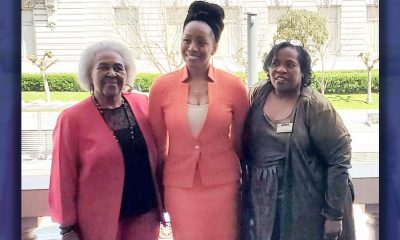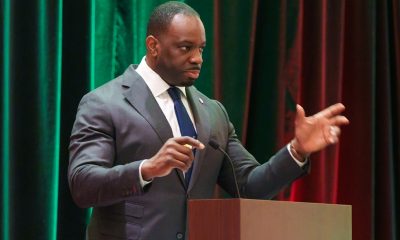Black History
“Colored Graveyard” Memorial Garden Dedication Held At SSU
THE SAVANNAH TRIBUNE — We often say in jest that we are going to the plantation when we really mean going to work. But a few years ago, construction workers of a new science and technology building at Savannah State University found signs of human remains. A new discussion began about the fact that this place was a plantation, the Placentia Plantation, located in between Thunderbolt and Skidaway Road in Savannah.
We often say in jest that we are going to the plantation when we really mean going to work. But a few years ago, construction workers of a new science and technology building at Savannah State University found signs of human remains.
A new discussion began about the fact that this place was a plantation, the Placentia Plantation, located in between Thunderbolt and Skidaway Road in Savannah.
The construction workers studied the dirt, and officials decided that though the “Colored Cemetery” was located somewhere in approximately 2.5 acres of the 700 acres where hundreds of men, women and children of enslaved people were buried here. There weren’t visible cemeteries on campus.
Some of us prayed for a resting place.
On Thursday, June 13, 2019, President Cheryl Davenport Dozier called together the community’s elders, ministers, professors, staff and groundsmen and women to pay homage to the enslaved people who toiled in the rice fields for hundreds of years before they were freed. She created a memorial garden. The garden is situated on the academic quad between Asa H. Gordon Library and the Sciences and Technology Building.
As far as we know, she is the 13th permanent president at the university and she created this type of official memorial for the first time. The Georgia Assembly created the Georgia State Industrial College to Colored Youth in 1891.
Thirteen other burial sites at churches, plantations and family memorials are located across Georgia are advertised. Last fall, some students at the University of Georgia wrote a resolution asking for officials to honor the enslaved people and to create a memorial there.
Perhaps, some of the descendants of Placentia’s plantation were present with alumni, friends and newcomers during the ceremony for the memorial. They lifted up a libation. They recognize that are able to study in a place that enslaved people could not. It was unlawful.
Other voices rang out: Elder Kwabena Bernard Jones, the Rev. Matthew Southall Brown Sr., Asiaunnya Bryant, Otis S. Johnson, Amir Jamal Toure, Peggy Blood, Ian Sainvil, Jessica Marsh, Andrew Okordudu, Clyde Newton, Nazil Compaore, Carolyn Vann Jordan and the Rev. Bernard Clarke. They shared inspirational words.
Dozier knew that some of us recognize the importance of history and the importance of speaking words for those of us who survived the Transatlantic African Slave Trade in the Middle Passage. Those of our ancestors were strong people, who built the pyramids and building this country. Some of us have been to the “No Return” at the shores of Ghana, Senegal, Nigeria and we’ve promised to return home to the Americas. The Sankofa, a Ghanian symbol, shows the importance of reaching back, gaining knowledge and giving it back.
I stood in gap holding a plaque of Sankofa, a picture of a bird looking backward, as our students Okordodu and Compaore shared how grateful they are that they are able to travel across the world to attend college on the site of a former plantation.
We heard the drums. Felt woven fabric. And, prayed again.
And, in unison, the group surrounded the palm trees and bushes around the mediation bench, and announced, “Aye,” a statement in Swahili in agreement.
On the Plaque: “This memorial garden is dedicated to the memory of enslaved African Americans labored and died on the 700-acre rice Placentia Plantation that was established in the eighteenth century, between the town of Thunderbolt and Skidaway Road in Savannah. The exact location of“colored graveyard” is not known, but it is believed to have been in this vicinity.This garden is in memorial to the enslaved families who were prohibited from learning to read and write but had hopes and dreams of freedom, equality, justice and education for future generations. It is fitting their final resting place is now an institute of higher education.
This article originally appeared in The Savannah Tribune.
Activism
Oakland Post: Week of April 17 – 23, 2024
The printed Weekly Edition of the Oakland Post: Week of April 17 – 23, 2024

To enlarge your view of this issue, use the slider, magnifying glass icon or full page icon in the lower right corner of the browser window. ![]()
Black History
Matthew Henson: Explorer Extraordinaire
Matthew Henson, a trailblazing explorer who overcame countless obstacles to leave an incredible mark on history. Born on August 8, 1866, in Charles County, Maryland, his journey is a testament to the power of determination and the spirit of adventure.

By Tamara Shiloh
Matthew Henson, a trailblazing explorer who overcame countless obstacles to leave an incredible mark on history. Born on August 8, 1866, in Charles County, Maryland, his journey is a testament to the power of determination and the spirit of adventure.
Henson’s life began amidst the backdrop of post-Civil War America, where opportunities for African Americans were scarce. From a young age, he possessed an insatiable curiosity about the world beyond his small town. At the age of 12, he embarked on a journey that would change the course of his life forever when he joined a merchant ship as a cabin boy.
His most famous expedition was his journey to the Arctic with renowned explorer Robert E. Peary. In 1887, Henson joined Peary’s crew as a seaman and quickly proved himself to be invaluable with his skills as a navigator and craftsman. Over the course of several expeditions, Matthew endured extreme cold, treacherous terrain, and grueling conditions as he and Peary sought to reach the elusive North Pole.
In 1908–09, Peary set out on his eighth attempt to reach the North Pole. It was a big expedition, with Peary planning to leave supplies along the way. When he and Henson boarded their ship, the Roosevelt, leaving Greenland on August 18, 1909, they were joined by a large group. This included 22 Inuit men, 17 Inuit women, 10 children, 246 dogs, 70 tons of whale meat, blubber from 50 walruses, hunting gear, and tons of coal.
In February, Henson and Peary left their anchored ship at Ellesmere Island’s Cape Sheridan, along with the Inuit men and 130 dogs. They worked together to set up a trail and supplies along the way to the Pole.
Peary picked Henson and four Inuit people to join him in the final push to the Pole. However, before they reached their destination, Peary couldn’t walk anymore and had to ride in a dog sled. He sent Henson ahead to scout the way. In a later interview with a newspaper, Henson recalled being in the lead and realizing they had gone too far. The group turned back, and Henson noticed his footprints helped guide them to their destination. At that location, Henson planted the American flag.
Henson’s legacy extends far beyond his expeditions to the Arctic. He shattered racial barriers in the world of exploration and inspired countless individuals, regardless of race, to dream big and pursue their passions. In 1937, he was finally recognized for his achievements when he was inducted into The Explorers Club, an organization dedicated to promoting scientific exploration and field research.
Matthew Henson died in the Bronx, New York, on March 9, 1955, at the age of 88.
Art
Marin County: A Snapshot of California’s Black History Is on Display
The Marin County Office of Education, located at 1111 Las Gallinas Ave in San Rafael, will host the extraordinary exhibit, “The Legacy of Marin City: A California Black History Story (1942-1960),” from Feb. 1 to May 31, 2024. The interactive, historical, and immersive exhibit featuring memorabilia from Black shipyard workers who migrated from the South to the West Coast to work at the Marinship shipyard will provide an enriching experience for students and school staff. Community organizations will also be invited to tour the exhibit.

By Post Staff
The Marin County Office of Education, located at 1111 Las Gallinas Ave in San Rafael, will host the extraordinary exhibit, “The Legacy of Marin City: A California Black History Story (1942-1960),” from Feb. 1 to May 31, 2024.
The interactive, historical, and immersive exhibit featuring memorabilia from Black shipyard workers who migrated from the South to the West Coast to work at the Marinship shipyard will provide an enriching experience for students and school staff. Community organizations will also be invited to tour the exhibit.
All will have the opportunity to visit and be guided by its curator Felecia Gaston.
The exhibit will include photographs, articles and artifacts about the Black experience in Marin City from 1942 to 1960 from the Felecia Gaston Collection, the Anne T. Kent California Room Collection, The Ruth Marion and Pirkle Jones Collection, The Bancroft Library, and the Daniel Ruark Collection.
It also features contemporary original artwork by Chuck D of the Rock and Roll Hall of Fame group Public Enemy, clay sculptures by San Francisco-based artist Kaytea Petro, and art pieces made by Marin City youth in collaboration with Lynn Sondag, Associate Professor of Art at Dominican University of California.
The exhibit explores how Marin City residents endured housing inequities over the years and captures the history of plans to remove Black residents from the area after World War II. Throughout, it embodies the spirit of survival and endurance that emboldened the people who made Marin City home.
Felecia Gaston is the author of the commemorative book, ‘A Brand New Start…This is Home: The Story of World War II Marinship and the Legacy of Marin City.’ Thanks to the generous contribution of benefactors, a set of Felecia’s book will be placed in every public elementary, middle, and high school library in Marin.
In addition, educators and librarians at each school will have the opportunity to engage with Felecia in a review of best practices for utilizing the valuable primary sources within the book.
“Our goal is to provide students with the opportunity to learn from these significant and historical contributions to Marin County, California, and the United States,” said John Carroll, Marin County Superintendent of Schools.
“By engaging with Felecia’s book and then visiting the exhibit, students will be able to further connect their knowledge and gain a deeper understanding of this significant historical period,” Carroll continued.
Felecia Gaston adds, “The Marin County Office of Education’s decision to bring the Marin City Historical Traveling Exhibit and publication, ‘A Brand New Start…This is Home’ to young students is intentional and plays a substantial role in the educational world. It is imperative that our community knows the contributions of Marin City Black residents to Marin County. Our youth are best placed to lead this transformation.”
The Marin County Office of Education will host an Open House Reception of the exhibit’s debut on Feb. 1 from 4 p.m. – 6 p.m.. All school staff, educators, librarians, and community members are encouraged to attend to preview the exhibit and connect with Felecia Gaston. To contact Gaston, email MarinCityLegacy@marinschools.org
-

 Activism4 weeks ago
Activism4 weeks agoOakland Post: Week of March 27 – April 2, 2024
-

 #NNPA BlackPress4 weeks ago
#NNPA BlackPress4 weeks agoFrom Raids to Revelations: The Dark Turn in Sean ‘Diddy’ Combs’ Saga
-

 #NNPA BlackPress4 weeks ago
#NNPA BlackPress4 weeks agoCOMMENTARY: D.C. Crime Bill Fails to Address Root Causes of Violence and Incarceration
-

 #NNPA BlackPress4 weeks ago
#NNPA BlackPress4 weeks agoCOMMENTARY: Lady Day and The Lights!
-

 #NNPA BlackPress4 weeks ago
#NNPA BlackPress4 weeks agoMayor, City Council President React to May 31 Closing of Birmingham-Southern College
-

 #NNPA BlackPress4 weeks ago
#NNPA BlackPress4 weeks agoBaltimore Key Bridge Catastrophe: A City’s Heartbreak and a Nation’s Alarm
-

 #NNPA BlackPress4 weeks ago
#NNPA BlackPress4 weeks agoBaltimore’s Key Bridge Struck by Ship, Collapses into Water
-

 #NNPA BlackPress4 weeks ago
#NNPA BlackPress4 weeks agoBeloved Actor and Activist Louis Cameron Gossett Jr. Dies at 87



















































